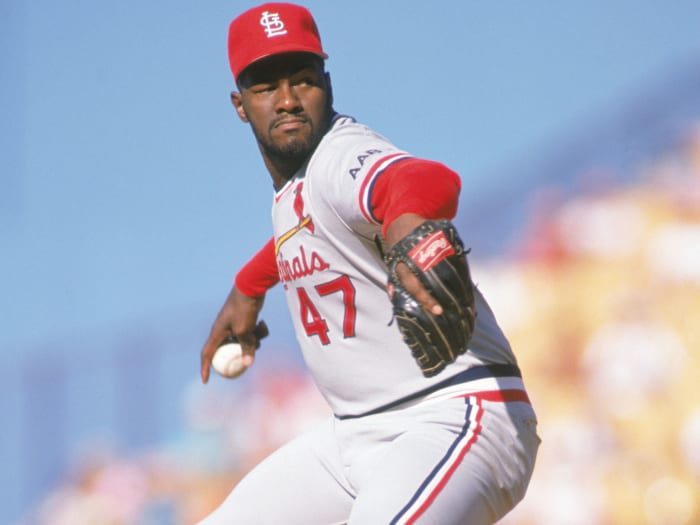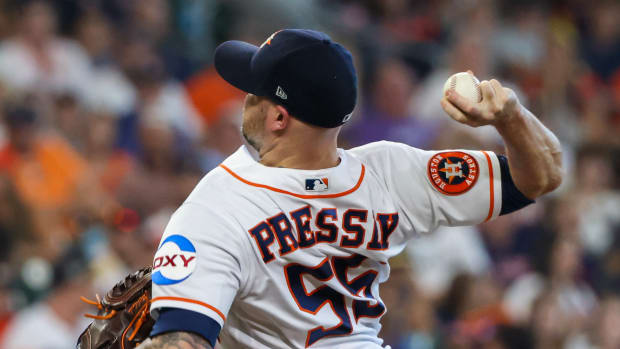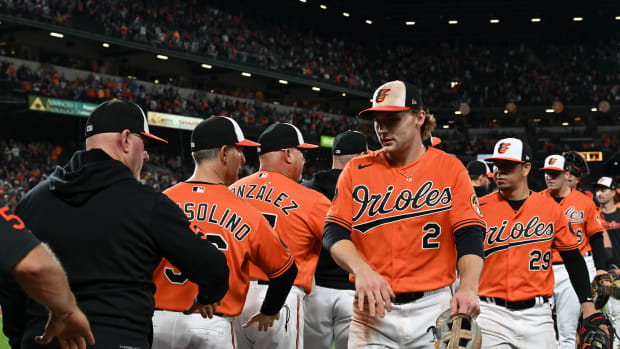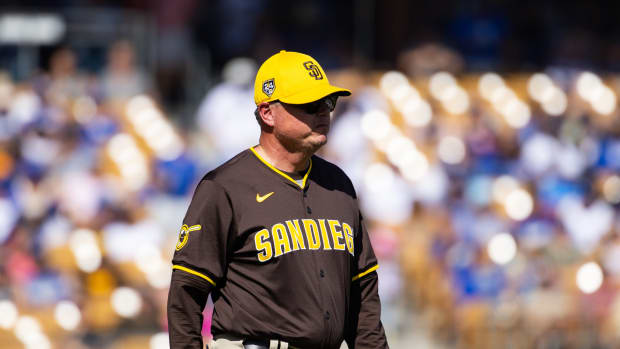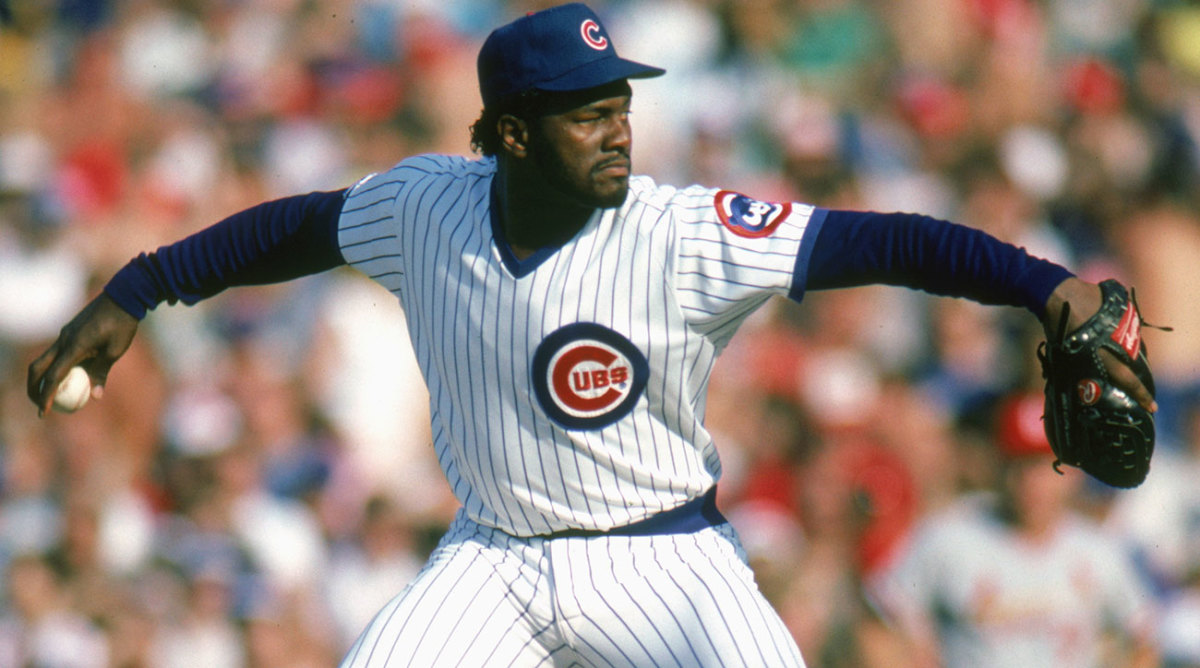
JAWS and the 2017 Hall of Fame ballot: Lee Smith
The following article is part of my ongoing look at the candidates on the BBWAA 2017 Hall of Fame ballot. Originally written for the 2013 election, it has been updated to reflect recent voting results as well as additional research. For a detailed introduction to this year's ballot, please see here. For an introduction to JAWS, see here.
Over the course of his 18-year career, Lee Arthur Smith was one of the game’s top closers. The physically intimidating (officially listed at 6'5", 220 pounds but reported as big as 6'6", 269 pounds) and mellifluously middle-named righty pitched for eight teams, earned All-Star honors seven times, led his league in saves four times (and finished as runner-up in four other seasons) and finished as high as second in the Cy Young voting. When he retired in 1998, he held the all-time record for saves with 478, a mark he owned from '93 to 2006.
When Smith retired, just two relievers had been elected to the Hall of Fame: Hoyt Wilhelm in 1985 and Rollie Fingers in '92. Since then (and since I debuted the system that became JAWS in the winter of 2003–04), that number has more than doubled via the elections of Dennis Eckersley ('04), Bruce Sutter ('06) and Rich Gossage ('08). In theory, the larger group made it at least somewhat easier to sketch out a standard for relievers, but within the stathead community, debate continues to rage over the proper way to value reliever contributions.
In particular, the focus has fallen on whether or not to incorporate win expectancy and leverage—the quantitatively greater impact on winning and losing that a reliever has at the end of the ballgame than a starter does earlier—into valuation metrics. Smartminds have come down on all sides of the issue, and as they have, the JAWS methodology for examining relievers has evolved more frequently than any other part of the system in an attempt to keep pace. The baseball-reference.com version of Wins Above Replacement does contain a leverage adjustment, but it also measures relievers against a higher replacement level than starters; as a group, relievers allow fewer runs per nine innings.
Relievers also throw far fewer innings than starters, so the result is that even among the elite, single-season WAR totals are lower than for even average starters, particularly as the job of closer has evolved into a one-inning role. Mariano Rivera, who now holds the all-time lead in saves, finished with a career WAR of 57.1, which ranks second among relievers behind Eckersley (who spent much of his career as a starter) but would place 77th among starting pitchers, between Dave Stieb and Orel Hershiser. Former all-time saves leader and 2016 Hall of Fame ballot debutante Trevor Hoffman, who had 51 fewer saves than Rivera, was almost exactly half as valuable: His career WAR of 28.4 would rank 312th among starters, in the general vicinity of Mike Moore, Jarrod Washburn and Jack McDowell—nobody you'd elect to the Hall of Fame. The peak scores of Rivera and Hoffmann stack up even less impressively if measured against starters: tied for 251st for the former and tied for 490th for the latter.
With the ongoing changes to JAWS, my verdict on Smith has changed as well. Since his retirement, Hoffman and Rivera have both surpassed his all-time saves record, and Smith’s progress toward Cooperstown, while substantial, has stalled. He's been on the BBWAA ballot for 14 years, debuting at 42.3% in 2003 and climbing as high as 50.6% in '12, but he's lost considerable ground since. In each of the past three cycles, he’s polled around 30%, squeezed out by a flood of stronger candidates, including starting pitchers. Being grandfathered in by the 2014 rule change that reduced candidates’ BBWAA ballot eligibility from 15 years to 10 didn't help, and it remains to be seen whether having his case considered by an Era Committee to be named later will either.
pitcher | career | peak | jaws | w | l | s | era | erA+ |
Lee Smith | 29.6 | 21.1 | 25.4 | 71 | 92 | 478 | 3.03 | 132 |
Avg. HOF RP | 40.6 | 28.2 | 34.4 |
|
|
|
|
|
A native of Jamestown, La., Smith was discovered by Negro Leagues legend Buck O'Neil, who spent decades as a scout for the Cubs. Chicago chose Smith in the second round of the 1975 draft and spent the first four years of his minor league career trying him as a starter, but control problems—including walk rates exceeding 7.0 per nine in some years—led the team to change course. By September 1980, Smith's command had improved enough for the Cubs to promote him to the majors, and they kept him busy, using him 18 times in their final 34 games, though rarely in the same game as then-closer Sutter, who was traded to the Cardinals in December.
Smith spent the entirety of the strike-shortened 1981 season with the Cubs, and after a brief five-game stint as a starter in June 1982, Chicago moved him into the closer's role, where he converted all 15 of his save opportunities from July 23 onward. In '83, Smith earned All-Star honors for the first time, leading the National League with 29 saves and pitching to a 1.65 ERA in 103 1/3 innings—the type of performance that would unfortunately become nearly obsolete by the end of the decade with the Eckersley-driven move to the one-inning closer. Four of Smith's saves were of three innings or more, 14 were of at least two innings and 19 were longer than one inning. His 4.8 WAR—a career high that he would never again come close to matching—ranked sixth in the league among all pitchers.
JAWS and the 2017 Hall of Fame ballot: Mike Mussina
Over the next four years, Smith compiled a 3.25 ERA and averaged 33 saves, finishing in the NL's top five in each season and helping the Cubs to their first postseason berth in 39 years in 1984. Alas, he surrendered a walk-off homer to the Padres' Steve Garvey in Game 4 of the NLCS, evening the series at two games apiece; San Diego would win in five. That blip aside, from 1983 to '87, Smith was the majors' second-most valuable reliever in terms of WAR, with his 14.7 trailing only Royals closer Dan Quisenberry's 16.6.
In December 1987, the Cubs traded Smith to the Red Sox for Al Nipper and Calvin Schiraldi. He pitched reasonably well in Boston, though he again struggled in the postseason, taking the loss in Game 2 of the 1988 ALCS against the Athletics. His workload continued to wane as the industry model moved toward a one-inning closer: In 1989, he threw just 70 2/3 innings, the sixth season out of seven that his total declined from the year before.
Despite that, Smith actually received an increased number of save opportunities. Traded to the Cardinals early in the 1990 season, he broke Sutter's NL saves record the following year with 47 in 53 attempts—the first of four straight years he would top 50 save chances. Accompanied by a 2.34 ERA, he finished second in the 1991 NL Cy Young balloting behind Braves ace Tom Glavine. He led the league in saves again with 43 in 1992, and in '93, his 46 saves not only pushed him past Jeff Reardon (357 saves) as the all-time leader but also made him the first to reach 400.
Save No. 400 came on Sept. 17, 1993 as a member of the Yankees, to whom the 35-year-old Smith had been traded on Aug. 31. That move began a particularly peripatetic phase, as he passed through Baltimore (1994, with a league-high 33 saves), Anaheim ('95 and '96), Cincinnati ('96) and Montreal ('97). The innings had taken their toll, and his managers limited his usage to about 50 innings per year, one at a time, to keep him effective, but he spent much of his final two seasons in a setup role with diminishing returns. In mid-July of 1997, he walked away from the Expos and abruptly announced his retirement, though he made a bid to crack the Royals' roster the following spring, then struggled in a stint with the Astros' Triple A team.
From a traditional standpoint, Smith's case for Cooperstown starts with his No. 3 ranking on the all-time saves list behind Hoffman (who broke his record in 2006) and Rivera (who took the crown in '11). That pair both topped 600 saves, but the vast majority of them required no more than three outs. In the 478 games in which he notched a save, Smith threw a total of 593 innings, just nine fewer than Hoffman did in the games in which he tallied his 601 saves. Smith’s total of 169 long saves—those of at least four outs—rank fourth behind Fingers (201), Gossage (193) and Sutter (188). His 1,022 games pitched ranked third when he retired, behind only Wilhelm and Kent Tekulve, but he is now tied for 12th.
Beyond that are Smith's seven All-Star selections and an amazing string of consistency that followed him to virtually every stop on his 18-year ride. Until his abbreviated final season, his ERA+ was always better than league average and was 32% better for his career. On the down side, his teams never went farther than the League Championship Series, and he was bombed for an 8.44 ERA in four postseason appearances, taking two losses.
JAWS and the 2017 Hall of Fame ballot: Barry Bonds
In terms of JAWS, the five closers in the Hall of Fame are strewn among the top 26 relievers, with Fingers ranking the lowest among that Cooperstown quintet. That ranking is at least somewhat skewed by pitchers' value as starters—Eckersley, for instance, made 361 career starts—but Smith, who made six starts and none after 1982, nevertheless ranks 14th in JAWS. Because of the way Eckersley's WAR total skews the standards, it's perhaps more instructive to note that relative to the others who are enshrined, Smith tops only Fingers (26.1) and Sutter (24.6) in career WAR and only Fingers (19.2) in peak WAR, and he falls short of the averages of the non-Eckersley quartet (35.0 career, 25.7 peak, 30.4 JAWS) on all three fronts. Given the small sample size of relievers in the Hall, it's fair to suggest that the voters are still in the process of fleshing out the standard, but the potential inclusions of both Hoffman (whose 67.3% in his 2016 debut makes his election an inevitability) and Rivera (eligible in 2019) would push Smith even further below the non-Eckersley standards (37.6 career, 25.2 peak, 31.4 JAWS).
While the version of WAR that’s used in JAWS features a leverage adjustment to help account for the degree of difficulty, it’s not the only way to measure reliever value. Win Probability Added (WPA) is a context-sensitive measure that accounts for the incremental increase (or decrease) in chances of winning produced in each plate appearance given the inning, score and base/out situation. For a reliever, a single-season WPA scales similarly to a single-season WAR, which is to say that it’s rare that one is worth more than three wins in a single year, by either measure. During the span of Smith’s 18 seasons, major league relievers combined to notch 110 seasons with at least 3.0 WAR and 103 seasons with at least 3.0 WPA. Alas, Smith’s 21.3 WPA doesn’t help his case any more than his WAR total does (note the discontinuity of rankings outside the top 10).
rank | player | wpa | ip |
1 | Mariano Rivera | 56.6 | 1,283 2/3 |
2 | Trevor Hoffman | 34.1 | 1,089 1/3 |
3 | Rich Gossage | 32.5 | 1,809 1/3 |
4 | Hoyt Wilhelm | 31.3 | 2,254 1/3 |
5 | Dennis Eckersley | 30.8 | 3,285 2/3 |
6 | Joe Nathan | 30.6 | 923 1/3 |
7 | Billy Wagner | 29.0 | 903 |
8 | Jonathan Papelbon | 28.4 | 725 2/3 |
9 | Francisco Rodriguez | 27.6 | 950 2/3 |
10 | Troy Percival | 23.6 | 708 2/3 |
14 | Lee Smith | 21.3 | 1,289 1/3 |
25 | Bruce Sutter | 18.2 | 1,042 |
28 | Rollie Fingers | 16.2 | 1,701 1/3 |
Likewise, when WPA is adjusted using a pitcher’s average leverage index (LI) for a stat variably called situational wins or context-neutral wins (referred to as WPA/LI), again Smith ranks modestly (12.9, 17th all-time), falling below every enshrined reliever but Sutter (11.9); Rivera (33.7) is again first and Hoffman (19.5) is fourth. As you can see, such numbers make a much stronger case for Hoffman than they do Smith.
By either my standard JAWS methodology or by more context-sensitive measures, it's difficult to conclude that Smith belongs in Cooperstown, and in his final turn on the BBWAA ballot, it's clear he'll fall short of 75%. The door isn’t entirely shut on him, however. Voting history smiles on candidates who attained the 50% mark at least once: Hoffman, Jeff Bagwell, Tim Raines, Curt Schilling, Jack Morris and Gil Hodges are the only ones who have reached that mark and remain outside, though the first three stand on the brink of election, and Schilling has five more years on the ballot after this. Both Smith and Morris potentially have years of small-committee processes ahead of them, and Hodges continues to surface, most recently on the 2015 Golden Era ballot.
That said, it's unclear which of the recently reconfigured Era Committees will take up Smith's case: the Modern Baseball one (for those whose biggest impact came between 1970–87, to be considered as part of the 2018 election cycle); or the Today's Game one (for those whose biggest impact came from '88 onward, next under consideration two years from now). Roughly 53% of his innings and 65% of his WAR came in the earlier period, but 62% of his saves, five of his seven All-Star appearances and his three top-five Cy Young finishes came in the later one. The Modern Baseball ballot is likely to be overstuffed with recent candidates such as Morris and Alan Trammell and perhaps long-lost ones such as Bobby Grich, Lou Whitaker and Ted Simmons. But even if Smith appears on the more sparsely populated Today’s Game one (where Mark McGwire was the only credible playing candidate in this year's balloting), it bears noting that not since the Veterans Committee's 2001 election of Bill Mazeroski has any small committee elected a living former player.
Then again, it's not unreasonable to think that Smith's level of support will work in his favor in front of a future committee that’s likely to be more focused on saves and other traditional accomplishments than WAR or WPA. He could win this one in extra innings.






























